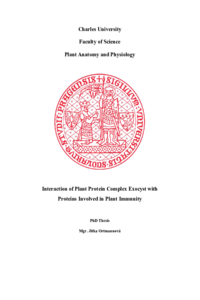Interaction of Plant Protein Complex Exocyst with Proteins Involved in Plant Immunity
Interakce rostlinného proteinového komplexu exocyst s proteiny zapojenými do rostlinné imunity
dizertační práce (OBHÁJENO)

Zobrazit/
Trvalý odkaz
http://hdl.handle.net/20.500.11956/99417Identifikátory
SIS: 144172
Katalog UK: 990021921010106986
Kolekce
- Kvalifikační práce [21483]
Autor
Vedoucí práce
Konzultant práce
Pečenková, Tamara
Potocký, Martin
Oponent práce
Burketová, Lenka
Ovečka, Miroslav
Fakulta / součást
Přírodovědecká fakulta
Obor
-
Katedra / ústav / klinika
Katedra experimentální biologie rostlin
Datum obhajoby
18. 6. 2018
Nakladatel
Univerzita Karlova, Přírodovědecká fakultaJazyk
Angličtina
Známka
Prospěl/a
Klíčová slova (česky)
exocyst, sekrece, Exo70, SNARE, haustoria, obranná papila;Klíčová slova (anglicky)
exocyst, secretion, Exo70, haustoria, defence papilaSouhrn Rostlina je sesilní organismus, proto je vybavena odolným povrchem v podobě buněčné stěny překryté ještě voděodpudivou kutikulou, který působí jako pasivní mechanická bariéra proti napadání různorodými škůdci. Rostlina se však dokáže také aktivně bránit a pomocí senzorických a sekrečních drah vnímat a dále odpovídat na případný útok. Mezní obranou reakcí každé buňky je indukovaná buněčná smrt. Rostlinná imunita je souborem těchto obranných mechanismů, které spojuje ve snaze zabránit infekci. Napadení patogenem většinou provází dočasné zastavení růstu a přesměrování metabolických i sekrečních drah na obranu. Sekreční dráhy rostlinné buňky a jejich regulace jsou tedy nezbytné pro růst i obranyschopnost. Proteinový komplex exocyst poutá sekretorické váčky k cílové membráně a hraje tak významnou úlohu v polarizaci sekreční dráhy. Po upoutání váčku exocystem dochází k energeticky náročné fúzi membrán, kterou řídí komplex SNARE. Během své práce jsem se zaměřila na identifikaci interakčních partnerů komplexu exocyst, kteří jsou zapojeni do rostlinné imunity. Ve spolupráci s kolegy jsem popsala přímou interakci podjednotek EXO70B2 komplexu exocyst a SYP121 komplexu SNARE. Dle našich výsledků oba komplexy spolupracují v sekretorické dráze, která je zapojena do obrany rostlin vůči průniku hub způsobujících...
Plants have an artillery to defend themselves. The plant surface is protected by water- resistant cuticle and mechanically strong cell wall. Then each plant cell has tools to recognize and to answer to a pathogen threat. In an extreme case, the answer is programmed cell death. Plant immunity is a complex process integrating these passive and active mechanisms in an effort to overstay a pathogen attack. When the plant cell is attacked by a pathogen, the metabolic resources are redirected towards immunity reaction which results in growth restriction. Both the immunity reaction and the growth are dependent on the efficient polarized secretion of various cargoes. Exocyst complex mediates tethering of a secretory vesicle with a target membrane and SNARE complex orchestrates the subsequent steps of vesicle docking and fusion. Exocyst and SNAREs are regulated by various proteins. In my work, I focused on identifying the exocyst interaction partners in plant immunity. In cooperation with my colleagues, we found the direct association between Qa-SNARE SYP121 involved in plant penetration resistance and EXO70B2 exocyst subunit. Moreover, we confirmed the relevance of their interaction for the formation of epidermal defensive structures, papillae and haustorial encasements in plant defence against non-adapted...
